Filter for water purification from the well: what are and
Own well is certainly good. After all, there will always be fresh water available, there is no dependence on the central water supply system and, moreover, you do not have to pay the meter. Rainbow picture at first glance.
However, there is a moment due to which the operation of a well can become a continuous headache. The point is that such a system often has problem points that can clog water. That is, water, at a minimum, will be supplied with sand, silt or just garbage, and at the maximum it will contain harmful impurities, such as iron, various nitrates.
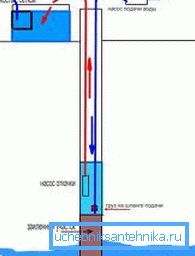
It is necessary to exclude such moments! And not only because such water is unpleasant and harmful to drink, but also because such a dirty mixture will constantly clog the hoses, pipes, and the taps themselves, in the end, which of course will lead to frequent breakdowns of the system or its individual elements.
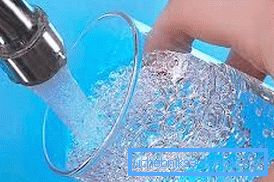
Here, in order not to harm health and prevent clogging of the well, usually filters are used to clean the water for the well. It would seem simple - bought, set and use. But not everything is so simple. The fact is that such devices are of various types and it’s not always possible to choose the right one. Especially to people who do not really understand this issue..
We will try to facilitate your choice - let's figure out which filter to clean the water from a well is optimally chosen in one way or another, and also consider what they are in general.
Let's start the review.
Two main types of filters
In fact, the types of filters are, of course, an order of magnitude greater than two, but it’s about the fact that these devices differ primarily in the following criteria:
- Devices designed to operate directly inside the wellbore. That is, simply speaking, these are filters that are installed at some point of the well itself (most often right at the point of entry of water from the aquifer into the system) and purify water from large mechanical debris. This, for example, may be sand, particles of silt, clay or some kind of organic matter.
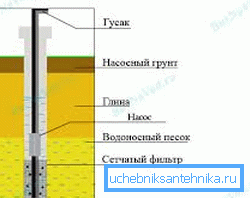
- Devices that are mounted above the ground. Most often these are ordinary household filters for cleaning water from a well - they are installed directly near the mixers. However, there are more complex ground systems, which are arranged directly “outside” - at the highest point of the wellbore.
In principle, both types of filters can be safely used together. For example, install a coarse cleaner inside the wellbore, and put another filter on the surface of the earth, thanks to which the smallest particles will be removed from the water, and a system that will help clean water from nitrates, iron, etc., will be removed directly near the crane
Tip: in order to choose the right device for final water purification, you must naturally have objective information about its composition. And here it is better not to assume, but to know for sure - give the liquid to the laboratory for analysis. For the money it will cost inexpensive, and the benefits will be mass. Because, for example, you may think that there is too much iron in the water, which means you need such and such a filter. And really - you will be right, but analysis can show that there is not only excess iron in the water, but also, for example, manganese, hydrogen sulfide or some nitrates. Therefore, in no case do not save on the expertise - do not risk your health!
Let's return to the review.
More detailed filter classification
It is worth noting that the information provided below will be useful to you in any case. After all, even if you do not plan to perform the installation of such devices with your own hands, then at least you will be able to control the correctness of the actions of the master, who will be engaged in installing the well filtration system for you.
In general, there is nothing “military” in these devices - just read carefully, study the types of filters and everything will become more or less clear.
Mesh, tubular and rod devices

In fact, these are the simplest filters for coarse well water, which have a cell size from 0.12 to 3 square mm. and are designed to remove sand and muddy particles from water.
Meshes, as a rule, are made of stainless steel and can have not one, but several layers, and with different shape of cells. In principle, the service life (in a normal environment) of these devices is quite high and the price is quite acceptable.
These well filters are doing very well with the task of cleaning, only there are a couple of nuances:
- Due to the high resistance of the steel and the frequency of the cells, the well will have low productivity. That is, quite simply, the water pressure in the faucet will not be very strong.
- When the filter is used in carbonate and ferruterous waters, the grids quickly fail, that is, under these conditions they will have to be changed frequently. Fortunately, there is a plus - the mesh filters are easily and quickly removed from the wells.
The next type of devices.
Holed and slotted filters

They represent a perforated pipe - it is installed in unstable soils, in which a fairly high content of fine crushed stone, gravel and pebbles. As a rule, such filters quietly block pebbles with a fraction size of up to 10 mm. and sand particles up to 2 mm in size.
Holed and slotted filters are very convenient to put for the purification of artesian water. After all, it is usually at this depth that such large foreign particles are present, and there is no fine sand.
Pay attention only to the fact that it is desirable to purchase a filter with stiffening ribs, since in their absence the perforated part of the device can be deformed under the influence of mechanical loads.
As for which filters are better - slotted or perforated, then everything is very simple to understand. The area of the gap is larger than the area of a single hole, which means that more water will enter the inside of the pipe through the gap.
In general, this system is quite durable and easy to install. But there are, of course, drawbacks - in an aggressive environment the filter screen will quickly deteriorate, and in a situation where the device works in soil with a high content of fine-grained sand, the holes in the mesh will often be blocked.
Further.
Wire Filters
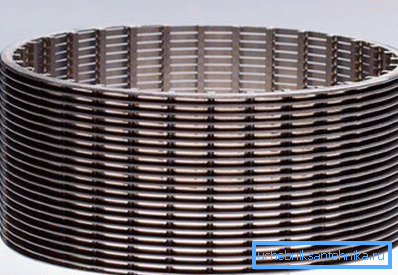
This device consists of a frame, a perforated pipe and a sump. It is used in artesian wells and sand. Installed inside the wellbore.
The device (provided that it is manufactured in full compliance with the rules and regulations) is very good, efficient and has a really long service life.
The disadvantages include the fact that such a water purification filter from a well will be difficult to clean from growths and contaminants. And if the casing and production are one pipe, then replace the filter will be simply unrealistic. Because the instruction of the assembly of the system in this case is such that during the replacement of the pipe it is necessary to mess around with almost the entire wellbore.
Gravel systems
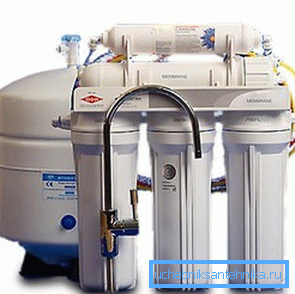
In fact, this system is designed for additional filtration of water. Such a filter is simply arranged - a well is sprinkled on the surface with a layer of sand or gravel, while the optimal layer thickness is 20-30 mm. If the sprinkling is done at the bottom of the well, then the layer thickness must be at least 5 cm.
That is, it is also a kind of mechanical coarse water filter for a well, only made not by using mechanisms and artificial materials, but from environmentally friendly natural components.
Now we will touch on the most popular ground systems, which are more designed for water disinfection.
Ion Exchange Installations

These are expensive filters, the purpose of which is that water enters the cartridge with a special resin, in which all the excess iron remains.
It seems to be good and reliable, but there is a nuance - the accumulated iron in the resin begins to oxidize over time and, accordingly, the filter no longer cleans so well and also “delivers” several other impurities to the faucet. In this case, it is almost impossible to clean the resin, so only one option is to change the cartridge with it. And this is not everyone can afford.
Osmotic systems

Filters of this type are also designed for indoor installation and are designed to purify water from excess iron and hydrogen sulfide.
However, there are no resins and additional reagents - water simply simply passes through a special membrane layer, on the surface of which harmful impurities and most bacteria remain.
In principle, inexpensive and effective, but only here the rate of flow of water into the faucet is not very high.
UV Sterilizers
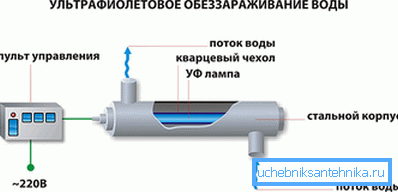
In essence, this is the irradiation of well water. The liquid passes through special channels inside which UV lamps are fixed.
Reliable, sterile and durable, but initially the purchase and installation of such a system will cost money.
Pay attention also to the fact that such sterilizers will, of course, clean the water, but clean what is called “from everything”. That is, almost all components are destroyed, and not only harmful ones. So using a UV system and, in general, terrestrial filters with any chemical and powerful reagents, you risk not getting mineral, so-called "living" water, but too much sterile water. Not harmful to use, but completely useless for health. So choose a system based on the objectives - if water is needed for washing dishes and cooking, then the UV sterilizer will do, but if you drink it, then you should think twice about which filter to use.
Let's sum up.
Conclusion
We consistently figured out what are the filters for water purification from a well, and also considered in which cases it would be relevant to apply one or another option. We hope that the information is useful to you. If you want to know more, we advise you to also watch the video in this article.